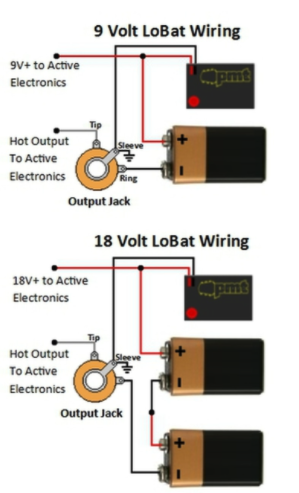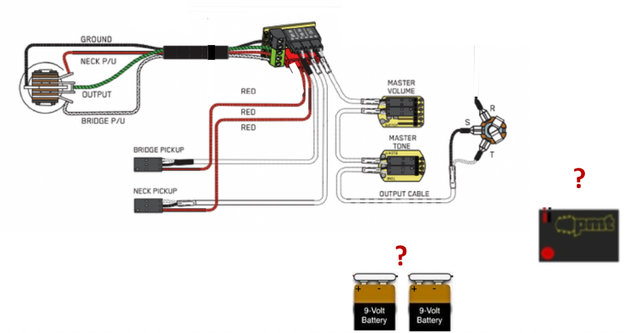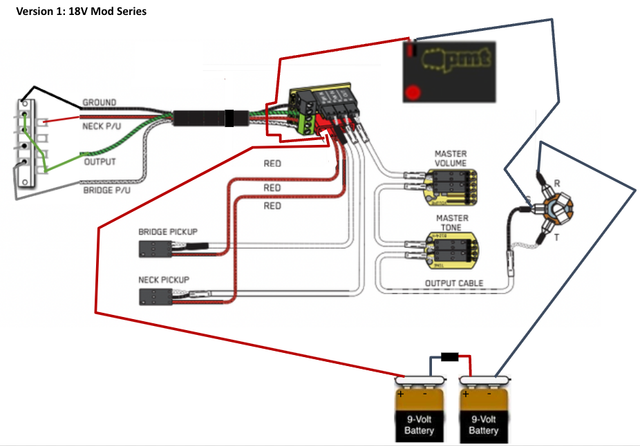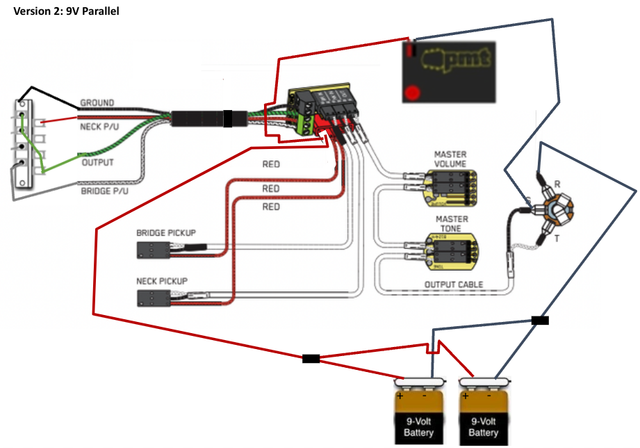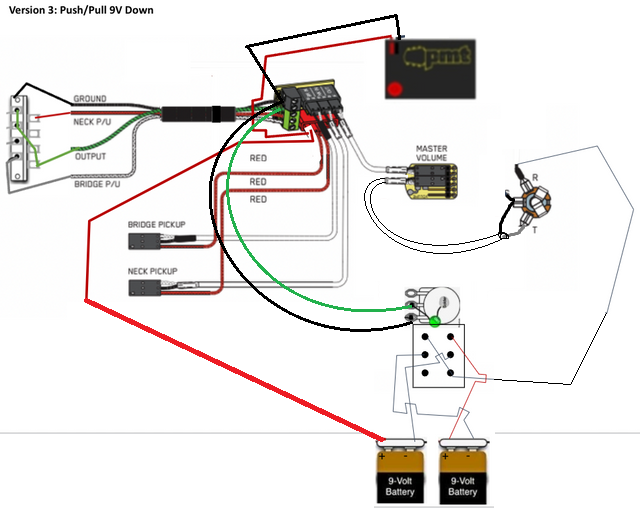alexreinhold
Senior Member
- Messages
- 739
Lately, I have been biting off a bit more than I can chew (if you have followed a couple of my other posts). But I guess that's how we learn. Anyway...
I am currently doing an EMG 81/60 installation that should look like this on the surface:
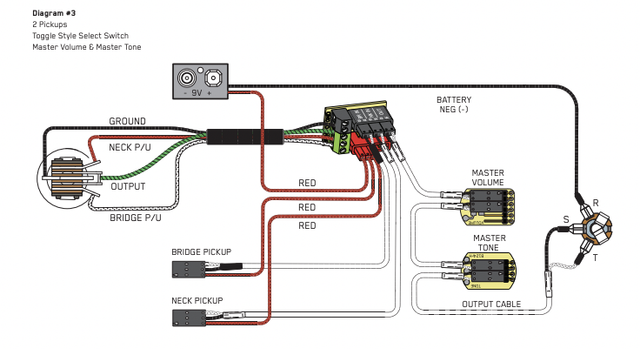
As you can see, this standard diagram assumes EMG's solderless system with a "buss" in the middle which acts as an intersection to all wires. However, here is what I want to achieve:
- 2 Pickups
- 3-way switch
- Master Volume
- 2 batteries (2x 9V),
- Push/Pull Master Tone (Push: 9V, Pull 18V) wired in Series Parallel
- Low battery indicator
Taking this step-by-step, the whole thing should look like this:
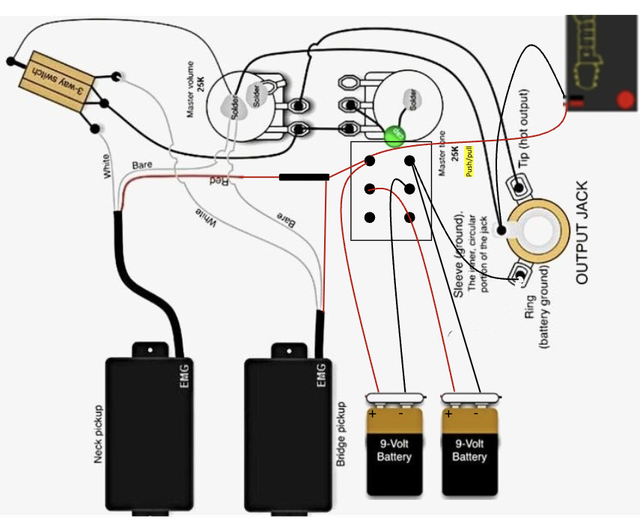
The following wiring diagram should work from physical perspective:
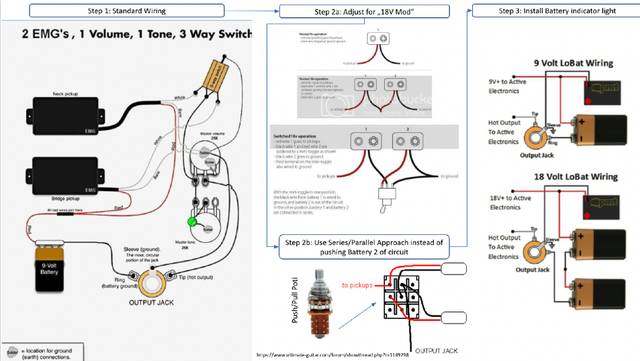
Now, given the EMG solderless system, I am facing a few problems I did not account for:
1. the EMG push/pull pot is designed for the solderless system:
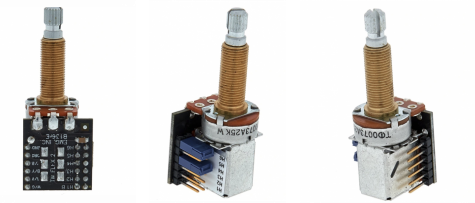
2. the Warmoth double battery box (which I am using) is NOT designed for the EMG solderless system
3. The Low-Battery Indicator (see pictures above), is NOT designed for the EMG solderless system
Problem: I have no clue how to solder to a solderless system.
So, I am thinking I have to go for a hybrid between solderless and soldered. Here is what I think:
General Remarks:
- keep the EMG solderless volume pot
- toss the complex solderless EMG push/pull pot and get a solder push/pull from Fishman or Allparts (25k of course).
For the pickups:
- keep connection to switch through buss as is
- cut red wire and connect to Fishman/Allparts push pull
For the volume pot:
- keep connection to switch through buss as is
- keep EMG wire that is supposed to go to the tone control solderless, cut it and connect the white end (i/o) to the Fishman/Allparts push pull. Tape off the black end (ground)
General Questions:
- do i need to any grounding on my 3-way blade switch (see above, not using toggle but blade)?
- will the solderless Fishman/Allparts push/pull need a cap?
What do you think?
I am currently doing an EMG 81/60 installation that should look like this on the surface:

As you can see, this standard diagram assumes EMG's solderless system with a "buss" in the middle which acts as an intersection to all wires. However, here is what I want to achieve:
- 2 Pickups
- 3-way switch
- Master Volume
- 2 batteries (2x 9V),
- Push/Pull Master Tone (Push: 9V, Pull 18V) wired in Series Parallel
- Low battery indicator
Taking this step-by-step, the whole thing should look like this:

The following wiring diagram should work from physical perspective:

Now, given the EMG solderless system, I am facing a few problems I did not account for:
1. the EMG push/pull pot is designed for the solderless system:

2. the Warmoth double battery box (which I am using) is NOT designed for the EMG solderless system
3. The Low-Battery Indicator (see pictures above), is NOT designed for the EMG solderless system
Problem: I have no clue how to solder to a solderless system.
So, I am thinking I have to go for a hybrid between solderless and soldered. Here is what I think:
General Remarks:
- keep the EMG solderless volume pot
- toss the complex solderless EMG push/pull pot and get a solder push/pull from Fishman or Allparts (25k of course).
For the pickups:
- keep connection to switch through buss as is
- cut red wire and connect to Fishman/Allparts push pull
For the volume pot:
- keep connection to switch through buss as is
- keep EMG wire that is supposed to go to the tone control solderless, cut it and connect the white end (i/o) to the Fishman/Allparts push pull. Tape off the black end (ground)
General Questions:
- do i need to any grounding on my 3-way blade switch (see above, not using toggle but blade)?
- will the solderless Fishman/Allparts push/pull need a cap?
What do you think?



